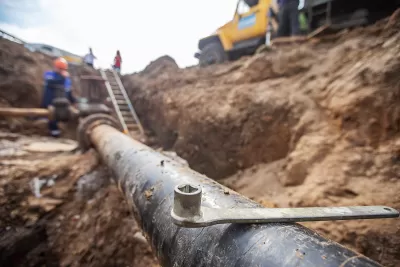The mandate doesn’t include additional funding, prompting backlash from utility companies.

A proposed rule from the Environmental Protection Agency (EPA) would require water utilities to identify and remove pipes with any level of lead over ten years, reports Kery Murakami for Route Fifty.
While the rule would not add new funding, “The 2021 Infrastructure Investment and Jobs Act did include $15 billion to remove lead pipes, as well as $11.7 billion in Drinking Water State Revolving Funds that can also be used for that purpose.” The industry estimates removing all lead pipes around the country could cost as much as $47 billion, saying they may be forced to raise rates for customers.
“But getting less notice is that agencies with the most lead pipes will get a little more time to meet the requirement,” Murakami adds. “Specifically, the agency said it would give utilities that have to replace more than 10,000 service lines a year ‘as many years as necessary’ to replace all the lead pipes “as quickly as feasible.’” The use of lead pipes for drinking water has been outlawed since 1986.
The proposal would also require cities to pass laws requiring private property owners to replace their own lead pipes or give the local utility access to do so. “The EPA argued that the cost of removing virtually all of the nation’s lead pipes is worth the price because of the harm they are causing to not only children but adults, too.”
FULL STORY: EPA proposes all lead pipes be replaced within 10 years

Alabama: Trump Terminates Settlements for Black Communities Harmed By Raw Sewage
Trump deemed the landmark civil rights agreement “illegal DEI and environmental justice policy.”

Planetizen Federal Action Tracker
A weekly monitor of how Trump’s orders and actions are impacting planners and planning in America.

The 120 Year Old Tiny Home Villages That Sheltered San Francisco’s Earthquake Refugees
More than a century ago, San Francisco mobilized to house thousands of residents displaced by the 1906 earthquake. Could their strategy offer a model for the present?

BLM To Rescind Public Lands Rule
The change will downgrade conservation, once again putting federal land at risk for mining and other extractive uses.

Indy Neighborhood Group Builds Temporary Multi-Use Path
Community members, aided in part by funding from the city, repurposed a vehicle lane to create a protected bike and pedestrian path for the summer season.

Congestion Pricing Drops Holland Tunnel Delays by 65 Percent
New York City’s contentious tolling program has yielded improved traffic and roughly $100 million in revenue for the MTA.
Urban Design for Planners 1: Software Tools
This six-course series explores essential urban design concepts using open source software and equips planners with the tools they need to participate fully in the urban design process.
Planning for Universal Design
Learn the tools for implementing Universal Design in planning regulations.
Clanton & Associates, Inc.
Jessamine County Fiscal Court
Institute for Housing and Urban Development Studies (IHS)
City of Grandview
Harvard GSD Executive Education
Toledo-Lucas County Plan Commissions
Salt Lake City
NYU Wagner Graduate School of Public Service


























